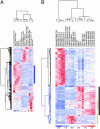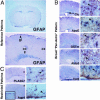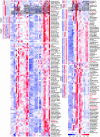Molecular diversity of astrocytes with implications for neurological disorders
- PMID: 15155908
- PMCID: PMC420403
- DOI: 10.1073/pnas.0402140101
Molecular diversity of astrocytes with implications for neurological disorders
Abstract
The astrocyte represents the most abundant yet least understood cell type of the CNS. Here, we use a stringent experimental strategy to molecularly define the astrocyte lineage by integrating microarray datasets across several in vitro model systems of astrocyte differentiation, primary astrocyte cultures, and various astrocyterich CNS structures. The intersection of astrocyte data sets, coupled with the application of nonastrocytic exclusion filters, yielded many astrocyte-specific genes possessing strikingly varied patterns of regional CNS expression. Annotation of these astrocyte-specific genes provides direct molecular documentation of the diverse physiological roles of the astrocyte lineage. This global perspective in the normal brain also provides a framework for how astrocytes may participate in the pathogenesis of common neurological disorders like Alzheimer's disease, Parkinson's disease, stroke, epilepsy, and primary brain tumors.
Figures



References
Publication types
MeSH terms
Substances
Grants and funding
LinkOut - more resources
Full Text Sources
Other Literature Sources
Medical

